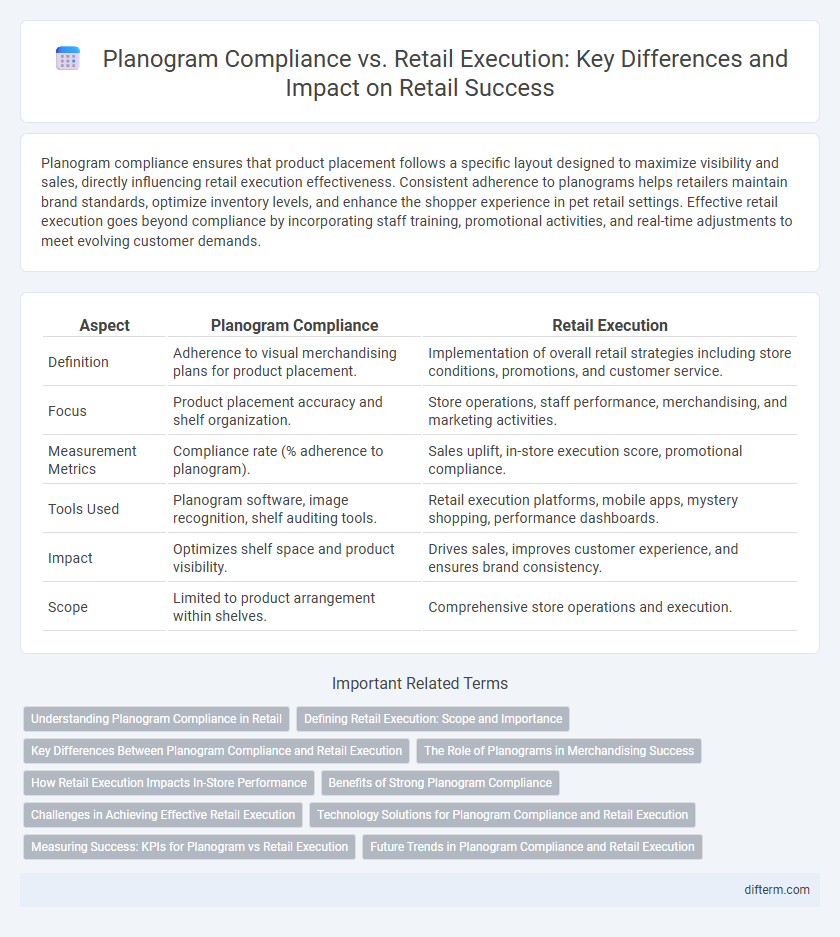Planogram compliance ensures that product placement follows a specific layout designed to maximize visibility and sales, directly influencing retail execution effectiveness. Consistent adherence to planograms helps retailers maintain brand standards, optimize inventory levels, and enhance the shopper experience in pet retail settings. Effective retail execution goes beyond compliance by incorporating staff training, promotional activities, and real-time adjustments to meet evolving customer demands.
Table of Comparison
| Aspect | Planogram Compliance | Retail Execution |
|---|---|---|
| Definition | Adherence to visual merchandising plans for product placement. | Implementation of overall retail strategies including store conditions, promotions, and customer service. |
| Focus | Product placement accuracy and shelf organization. | Store operations, staff performance, merchandising, and marketing activities. |
| Measurement Metrics | Compliance rate (% adherence to planogram). | Sales uplift, in-store execution score, promotional compliance. |
| Tools Used | Planogram software, image recognition, shelf auditing tools. | Retail execution platforms, mobile apps, mystery shopping, performance dashboards. |
| Impact | Optimizes shelf space and product visibility. | Drives sales, improves customer experience, and ensures brand consistency. |
| Scope | Limited to product arrangement within shelves. | Comprehensive store operations and execution. |
Understanding Planogram Compliance in Retail
Planogram compliance measures how accurately retail stores follow the predefined product placement and shelving guidelines designed to optimize space and enhance shopper experience. Effective retail execution ensures that planogram standards are consistently implemented, improving product visibility, customer engagement, and sales performance. Monitoring compliance through audit tools and data analytics helps retailers identify gaps and maintain brand consistency across locations.
Defining Retail Execution: Scope and Importance
Retail execution encompasses the comprehensive process of implementing retail strategies on the ground, including product placement, merchandising, pricing, and customer engagement. It ensures that planogram compliance, promotional activities, and inventory management align with corporate objectives to maximize sales and enhance customer experience. Effective retail execution drives consistent brand representation and operational efficiency across multiple store locations.
Key Differences Between Planogram Compliance and Retail Execution
Planogram compliance measures how accurately products are arranged on shelves according to a predefined planogram, ensuring optimal product placement and inventory visibility. Retail execution encompasses a broader scope, including merchandising, pricing, promotions, and overall store conditions to drive sales and enhance customer experience. Understanding the distinction is crucial for retailers aiming to optimize operational efficiency and maximize sales performance.
The Role of Planograms in Merchandising Success
Planogram compliance ensures that products are displayed exactly as designed, optimizing shelf space and driving sales. Precise adherence to planograms enhances retail execution by providing a consistent shopping experience, improving inventory management, and maximizing product visibility. Effective merchandising success relies on the integration of planogram accuracy and real-time execution to meet consumer demand and promotional goals.
How Retail Execution Impacts In-Store Performance
Retail execution directly influences in-store performance by ensuring that planogram compliance is maintained, which optimizes product placement and maximizes shelf visibility. Effective retail execution drives consistent merchandising, improves stock availability, and enhances the customer shopping experience, leading to increased sales and brand loyalty. Data analytics tools provide real-time insights into compliance levels, enabling swift corrective actions to maintain planogram standards and boost operational efficiency.
Benefits of Strong Planogram Compliance
Strong planogram compliance ensures optimal product placement, which maximizes shelf space utilization and boosts sales by guiding shopper behavior effectively. Consistent adherence to planograms facilitates accurate inventory management and reduces out-of-stock situations, enhancing customer satisfaction. Retailers benefit from improved brand presentation and increased operational efficiency, driving higher overall profitability.
Challenges in Achieving Effective Retail Execution
Retail execution faces significant challenges due to inconsistent planogram compliance, which directly impacts product placement and inventory management. Discrepancies between planned and actual shelf arrangements lead to lost sales opportunities and hinder accurate demand forecasting. Ensuring strict adherence to planogram standards requires advanced monitoring tools and regular staff training to optimize shelf visibility and customer experience.
Technology Solutions for Planogram Compliance and Retail Execution
Technology solutions for planogram compliance and retail execution leverage AI-driven image recognition and real-time data analytics to ensure shelves align with predefined layouts and merchandising standards. Mobile applications and cloud-based platforms facilitate seamless communication between store associates and management, enabling rapid corrective actions and performance tracking. Integration of IoT sensors enhances inventory accuracy and optimizes product placement, driving improved sales and customer satisfaction.
Measuring Success: KPIs for Planogram vs Retail Execution
Planogram compliance measures the accuracy of shelf arrangements against predefined layouts, focusing on KPIs such as shelf share, out-of-stock rates, and visual merchandising quality. Retail execution encompasses broader in-store activities, tracking KPIs like sales uplift, promotional compliance, and customer engagement metrics. Comparing these KPIs reveals how precise product placement drives retail success versus the overall effectiveness of in-store strategies.
Future Trends in Planogram Compliance and Retail Execution
Future trends in planogram compliance and retail execution emphasize the integration of AI-powered analytics and real-time shelf monitoring to enhance accuracy and operational efficiency. Advanced image recognition technologies facilitate automatic detection of product placement discrepancies, enabling retailers to swiftly address compliance issues. Omnichannel retail strategies drive the need for dynamic planograms that adapt to consumer behavior and inventory fluctuations across physical and digital platforms.
Planogram Compliance vs Retail Execution Infographic

 difterm.com
difterm.com